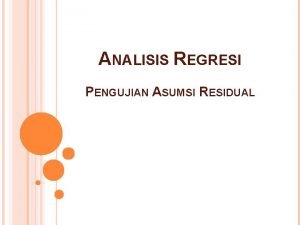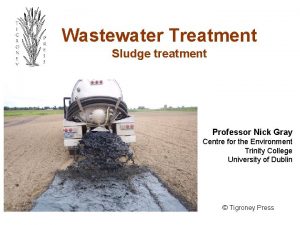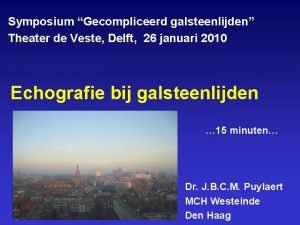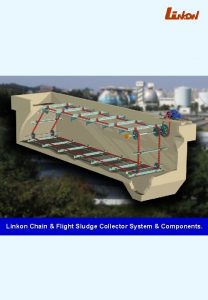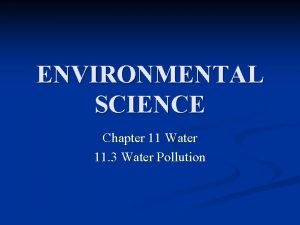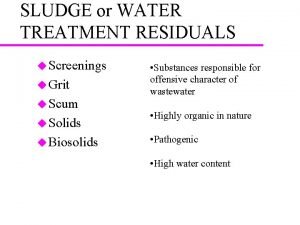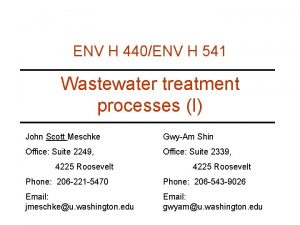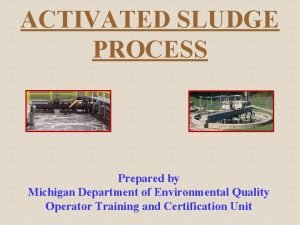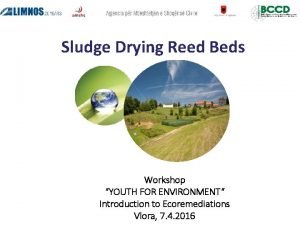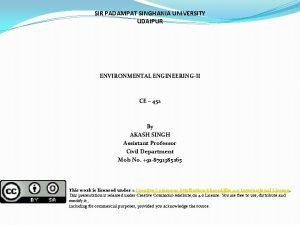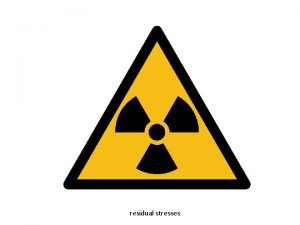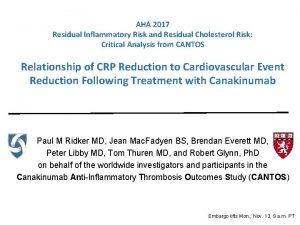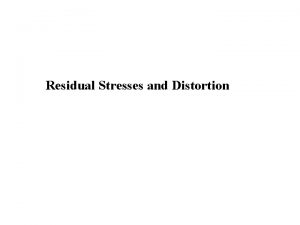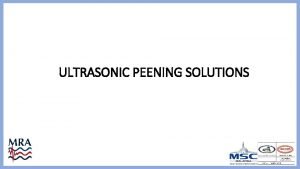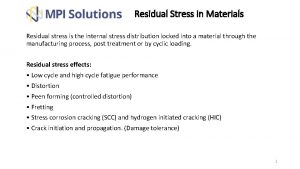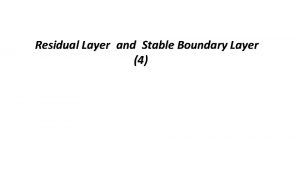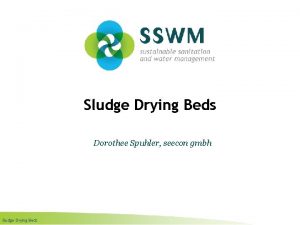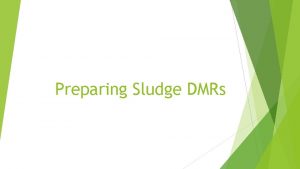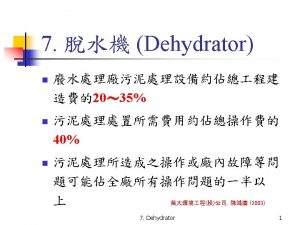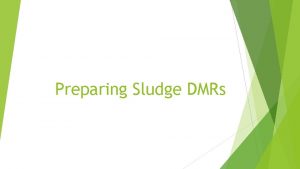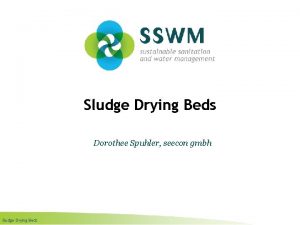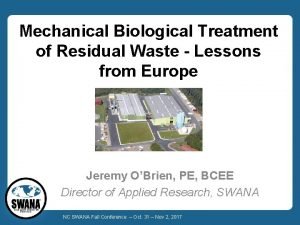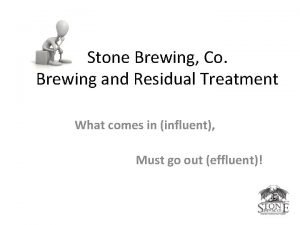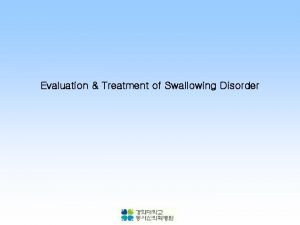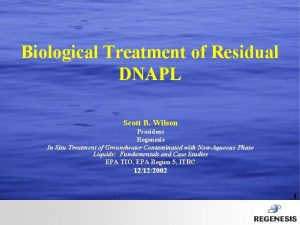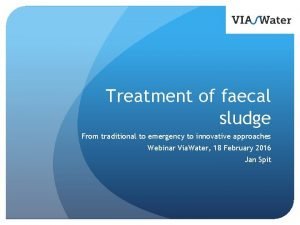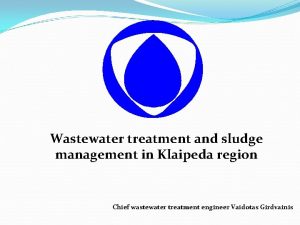SLUDGE TREATMENT SLUDGE SLUDGE refers to the residual
























- Slides: 24

SLUDGE TREATMENT

SLUDGE • SLUDGE refers to the residual, semisolid material left from the industrial wastewater or sewage treatment processes. • It can also refer to the settled suspension obtained from conventional drinking water treatment and numerous other industrial processes. • The term is also sometimes used as a generic term for solids separated from suspension in a liquid; this 'soupy' material usually contains significant quantities of 'interstitial' water (between the solid particles).

SOURCES OF SLUDGE • Sludge is produced from the treatment of wastewater in on-site (e. g. septic tank) and off-site (e. g. activated sludge) systems. • A primary aim of wastewater treatment is removing solids from the wastewater. • In addition, soluble organic substances are converted to simple compd. By bacterial cells, and the latter is removed from the wastewater. • Sludge is also produced from the treatment of storm water, although it is likely to be less organic in nature compared to wastewater sludge.

SLUDGE TREATMENT • Primary solids and secondary biosolids accumulated in a wastewater treatment process must be treated and disposed of in a safe and effective manner. • This material may be contaminated with toxic organic and inorganic compounds (e. g. heavy metals). • Options for sludge treatment include digestion, thickening, dewatering or drying and incineration. • The latter is most costly, because fuel is needed and air pollution control requires extensive treatment of the combustion gases. It can be used when the sludge is heavily contaminated with heavy metals or other undesirable pollutants. Prevention of contamination of the sludge by industrial wastes is preferable to incineration.


1. Digestion • Many sludges are treated using a variety of digestion techniques, the purpose of which is to reduce the amount of organic matter and the number of disease-causing microorganisms present in the solids. • The most common treatment options include i) anaerobic digestion, ii) aerobic digestion, iii) composting.

a. Aerobic Digestion • Aerobic digestion is a bacterial process occurring in the presence of oxygen. • Under aerobic conditions, bacteria rapidly consume organic matter and convert it into carbon dioxide. • Once there is a lack of organic matter, bacteria die and are used as food by other bacteria. This stage of the process is known as endogenous respiration. • Solids reduction occurs in this phase. Because the aerobic digestion occurs much faster than anaerobic digestion, the capital costs of aerobic digestion are lower. • However, the operating costs are characteristically much greater for aerobic digestion because of energy costs for aeration needed to add oxygen to the process.

b. Anaerobic Digestion • Anaerobic digestion is a bacterial process that is carried out in the absence of oxygen. • The process can either be thermophilic digestion in which sludge is fermented in tanks at a temperature of 55°C or mesophilic, at a temperature of around 36°C. • Anaerobic digestion is a bacterial decomposition process that stabilizes organic wastes and produces a mixture of methane and carbon dioxide gas (biogas). • The heat value of methane is the same as natural petroleum gas, and biogas is valuable as an energy source.

• Anaerobic digestion is usually carried out in a specially built digester, where the content is mixed and the digester maintained at 35◦C by combusting the biogas produced. • After digestion the sludge is passed to a sedimentation tank where the sludge is thickened. Biogas is collected from the digester. The thickened sludge requires further treatment prior to reuse or disposal.

• Anaerobic digestion can also be carried out at a slower rate in an unmixed tank or pond. Covering is usually by a UV resistant plastic sheet, because of the large area needed to be covered, and biogas is collected from the top of the sheet. Storage of biogas can be in a cylindrical tank with a floating roof. The cylindrical roof floats on water and its position is determined by the volume of the gas stored under the pressure of the roof. Biogas can also be stored in a balloon, but only under low pressure.


c. Composting • Composting is an aerobic bacterial decomposition process to stabilize organic wastes and produce humus (compost). • Compost contains nutrients and organic carbon which are excellent soil conditioners. • Composting takes place naturally on a forest floor where organic materials (leaf litter, animal wastes) are converted to more stable organic materials (humus) and the nutrients are released and made available for plant uptake. • The process is slow on a forest floor, but can be accelerated under optimum conditions.

compost

• The optimum conditions for composting are a moisture content of about 50 %, a carbon to nitrogen ratio of about 25 to 30, temperature of 55 C. • Because wastewater sludge is rich in nutrients, its carbon to nitrogen ratio is low (5 to 10). It is also high in moisture. • Addition of dry sawdust, which is very high in carbon to nitrogen ratio can adjust both the moisture and carbon to nitrogen ratio. Other waste materials that can be used for this purpose are mulched garden wastes, forest wastes and shredded newspaper.


2. Thickening • Sludge contains a high concentration of solids, but its water content is still high. Combined primary and secondary sludge from an activated sludge treatment plant contains about 2 % solids and hence 98 % water. • One kg of dry sludge is associated with 49 L of water. Thickening to 5 % solids means one kg of dry solids is associated with 19 L of water, thus 30 L of water has to be removed. • Thickening is carried out in a sedimentation tank or in a sedimentation pond. The latter is advantageous if land area is available, because the sludge can be allowed to settle over a much longer period and a higher solids content of the thickened sludge is achieved. • The water removed from thickening needs treatment. It can be returned to the inlet of an off-site wastewater treatment plant, or in the case of sludge from on-site units by an aerobic treatment process.


3. Dewatering/ Drying • Dewatering aims to reduce the water content further so that the solids content of the sludge is about 20 % (equivalent to 1 kg dry sludge with 4 L of water). The sludge can then be handled like a solid. • Dewatering can be done mechanically using a filter press (employing pressure or vacuum), or a centrifuge. • It can also be done using drying beds.

• A drying bed consists of a 30 cm bed of sand with an underdrainage. Sludge is applied on the sand bed and is allowed to dry by evaporation and drainage of excess water over a period of several weeks depending on climatic conditions. • Bacterial decomposition of the sludge takes place during the drying process while moisture content is sufficiently high. • During the rainy season the process may take a longer time to complete and sizing the area of the drying beds should take this into account.


4. Sludge Reuse • Reuse of composted sludge as a soil conditioner in agriculture and horticulture returns carbon, nitrogen, phosphorus and elements essential for plant growth back to the soil. • Less chemical fertilizers are required and the organic carbon helps to improve soil structure for soil aeration, water percolation and root growth. • The nitrogen and phosphorus are also released gradually for plant uptake compared to the more soluble chemical fertilizers. • The potential of leaching of the nutrients to ground or surface water by rainfall run-off is much reduced. Pathogens and heavy metals can, however, limit the reuse of sludge.

5. Sludge Disposal • Final or ultimate disposal of sludge, which cannot be reused, is by land filling or incineration. • Since sludge for landfilling usually contains heavy metals or toxic chemicals, lining of the landfill with clay or plastic liner may be required to prevent contamination of groundwater. • Incineration of sludge is by a multiple hearth furnace or fluidized bed furnace. Energy input is required to dry the sludge before combustion is self-sustaining. Combustion flue gases usually need treatment to meet air pollution control standards. Investment and operating costs are high.


• THANKS
 Sisaan
Sisaan Sludge treatment
Sludge treatment Galsteenlijden
Galsteenlijden Flight sludge collector
Flight sludge collector Sludge press
Sludge press Objective of water pollution
Objective of water pollution Plasmorrhagia definition
Plasmorrhagia definition Prehepaticus
Prehepaticus Sludge drying beds
Sludge drying beds Secondary wastewater treatment
Secondary wastewater treatment Sludge density index formula
Sludge density index formula Activated sludge process flow chart
Activated sludge process flow chart Negreplisse
Negreplisse Activated sludge process
Activated sludge process Thiếu nhi thế giới liên hoan
Thiếu nhi thế giới liên hoan Fecboak
Fecboak Các châu lục và đại dương trên thế giới
Các châu lục và đại dương trên thế giới Một số thể thơ truyền thống
Một số thể thơ truyền thống Thế nào là hệ số cao nhất
Thế nào là hệ số cao nhất Lp html
Lp html Sơ đồ cơ thể người
Sơ đồ cơ thể người Tư thế ngồi viết
Tư thế ngồi viết Số nguyên tố là gì
Số nguyên tố là gì Hát kết hợp bộ gõ cơ thể
Hát kết hợp bộ gõ cơ thể đặc điểm cơ thể của người tối cổ
đặc điểm cơ thể của người tối cổ
